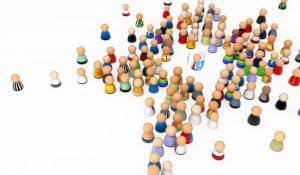Social anxiety, a disorder characterized by overwhelming anxiety and excessive self-consciousness, is a condition that can disrupt daily life.
People living with this disorder may have minimal romantic or social interactions, making them feel ashamed or even powerless.
Low self-esteem and excessive shyness are some of the symptoms associated with this condition. Let’s examine some social anxiety statistics to understand better.
Social Anxiety Statistics
Facts About Social Anxiety Disorder (SAD)
SAD (short form of social anxiety disorder) is the 3rd most common mental health issue reported across the world. According to the latest epidemiological data, about 7% of the population suffers this condition at any given time. Further, the lifetime prevalence rate of this condition stands at above 13%.
The typical age of onset is 13 years old meaning that a significant section of society is at risk of suffering from this condition at least once in their lifetime. Despite the obvious dangers of this disorder, only 64% are taking action after spotting its symptoms within the first ten years of diagnosis. 36 percent take longer than ten years before seeking professional support.
According to the Anxiety and Depression Association of America, US citizens alone spent well over $42 billion in 1998-1999. This represented about a third of the country’s total mental health bill which was above $148. The study further showed that a significant portion of those costs was associated with repeated use of health care services as most people suffering from social anxiety tend to seek relief for symptoms that mimic physical illnesses.
Social anxiety disorders in teens
According to a study published in the journal Pediatrics, a team of researchers from the National Institute of Mental Health (NIMH) was reported regarding a sample of more than 10,000 teenagers. The following crucial social anxiety statistics were collected.
*Nearly 50% of the girls and 43% of the boys confessed to being “somewhat” or “very” shy
*About 12.4% of the teens seemed to meet the criteria for social anxiety as outlined in the Diagnostic and Statistical Manual of Mental Disorders
*10% of older teens between 17 and 18 years of age were reported to suffer from social anxiety as compared to 6% of their younger counterparts aged between 13 and 14 years.
Social Anxiety in adults
Social anxiety statistics show that 6.8% of US adult population suffer this condition every year. Of those affected, 29.9% (representing 2% of the entire US adult population) are classified as severe. Further statistics on prevalence rate include:
*The most affected adult age bracket is aged between 30-44 years old with 14.3% facing the high possibility of suffering from the condition. This is comparable to 13.6% for age bracket 18-29 year, 12.4% for age bracket 45-59 year and 6.6% of those aged 60+.
Treatment statistics
40.1% of the adults with this disorder are currently receiving treatment. 38.7% of those under treatment are reportedly receiving minimally adequate treatment – this represents 15.5 percent of the total number of people living with this disorder. Only 5% of those living with SAD get the right treatment and sadly 25% of patients decline when offered behavioral treatment.
This is by far a non-exhaustive list of social anxiety statistics. All the same, it perfectly serves the purpose of informing the reader about some of the most important facts concerning this common mental condition.
